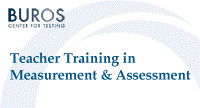Buros-Nebraska Series on Measurement and Testing

Teacher Training in Measurement and Assessment Skills
Date of this Version
1993
Document Type
Article
Citation
Published in Teacher Training in Measurement and Assessment Skills, edited by Steven L. Wise (Lincoln, NE: Buros Institute of Mental Measurements, University of Nebraska–Lincoln, 1993).
Abstract
INTRODUCTION
In his role as a discussant of a series of papers on educational evaluation 23 years ago, Scriven (1970) made the following comments:
While the papers this afternoon did not, on the above accoW1t, go far enough in the direction of basic evaluation, from another point of view they began at too abstract a level. They contain no discussion at all of the basic method of educational evaluation, one whose use quantitatively swamps any other. I refer to the practice of grading. Like so many other everyday practices, grading has often seemed too humble to merit the attention of high-powered test and measurement people. My feeling is that it is far more important and in more need of help than anything else they work on. Moreover it admirably illustrates the point just made, that the new critics of bad practices are about as irrational as most defenders of the practices. (p. 114)
Unfortunately, little has changed since this observation was made.
Reference Works on Educational Measurement and Research
A brief review of three standard reference works reveals a general disdain for the topic of grading. The recently published third edition of Educational Measurement (Linn, 1989) contains two chapters that might logically be expected to touch on grading. Chapter 12, entitled "Designing Tests That Are Integrated with Instruction," identifies attainment decisions as one of four types of decisions for which tests are employed. The author devotes approximately one-half page (out of 24 in the chapter) to this type of decision and never mentions grading in relation to attainment. Chapter 14, entitled "Certification of Student Competence," provides a lengthy review of statewide competency testing programs and issues associated with standard setting in such programs. The author has nothing to say about the teacher's role in the certification of competence and standard setting as it relates to grading.
Apparently it simply doesn't occur to measurement specialists that classroom teachers are the ones who have the primary responsibility for making attainment decisions and certifying student competence. The terms grades and grading do not appear in the index of Educational Measurement (Linn, 1989).
A second standard reference is the third edition of the Handbook of Research on Teaching (Wittrock, 1986). The three chapters in this volume that would logically be linked to grading practices are Chapter 13 ("Teaching Functions"), Chapter 14 ("Classroom Organization and Management"), and Chapter 17 ("Philosophy of Teaching"). None of these chapters contains any reference to grades.


Comments
Copyright © 1993 by Buros Institute of Mental Measurements. Digital edition copyright © 2012 Buros Center for Testing. This book may be downloaded, saved, and printed by an individual for their own use. No part of this book may be re-published, re-posted, or redistributed without written permission of the holder of copyright.